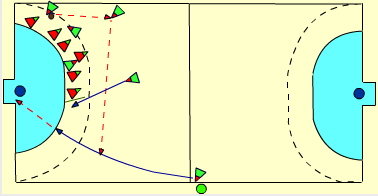Handball drills for technique defense
- LH plays pass to LO
- LO plays pass to MO who starts towards UR
- MO puts direct pressure with barrage on UR and plays pass to backward starting LH, LO starts in for barrage on MA
- LH puts direct pressure on MA-r and plays pass to starting RO
- RO uses the space and finishes
- The ball is passed on to RB, who runs in and shoots between the screening LB and CR.
- LH plays pass to LO and starts in for pressure between MA and UR
- LO plays pass to starting MO
- After receiving ball MO starts in towards UR, puts a barrier in front of UR on the inside of UR and MO plays a pass to the starting LH, at the same time LO starts in parallel to LH.
- LH plays a pass to the starting LO
- LO completes
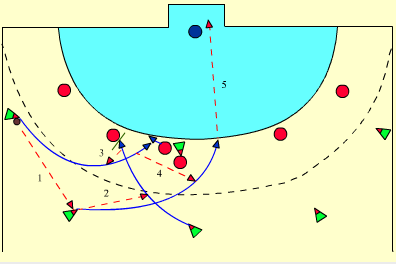
- RO plays pass to starting MO
- MO starts to the left, sets up a switch with and plays pass to LO starting from behind; MO starts further towards left corner.
- LO puts pressure on the middle block, sets up for a throw. LH starts in along the circle, probably taking HR and UR inside. If LO cannot finish herself, she turns and plays a pass to the starting free MO.
- MO completes
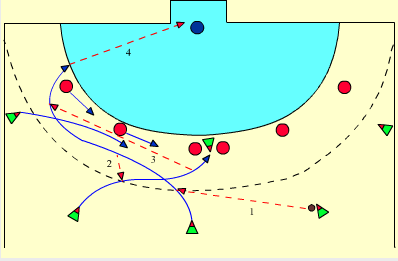
- MO starts outside in, causing MV to probably follow MO, MO plays counter pass to in-street LO and puts pressure on UL
- LO puts direct pressure on UR and switches with LH, RH starts to inside in
- LH starts towards the middle, causing UR to probably follow LH, and sets up a swap with RH starting from the back
- RH completes
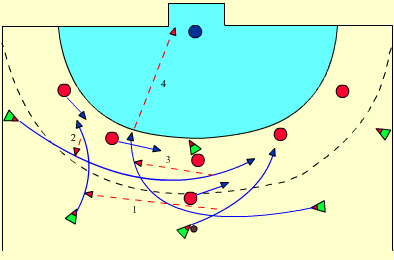
- MO plays pass to incoming LO
- LO puts direct pressure on UR and sets up swap with LH
- LH sees that there is no space and starts in towards the middle, plays pass to in starting RO, LH holds back slightly
- RO puts direct pressure on UL and sets up changeover with RH
- RH plays pass to in starting LH
- LH finishes with a jump throw or a breakthrough
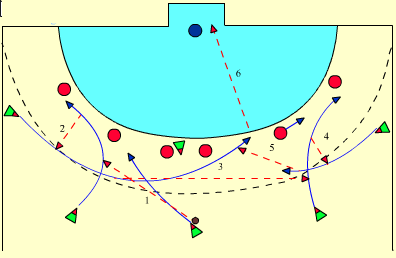
- MO plays pass to LO who starts in left corner
- LH starts behind LO for pressure between UR and MA-r, LO plays pass to starting MO
- MO pressures between MA-l and UL and plays pass to starting LH, CS sends in MA-r
- LH takes advantage of the space and finishes
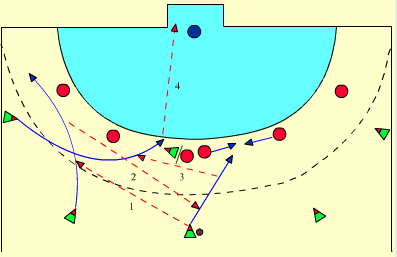
- RO plays pass to left corner starting MO
- MO puts pressure on UR and plays pass to starting RO, LO starts in towards middle
- RO puts pressure between MA-l and UL and plays pass to starting LO, CS puts bar on MA-r
- LO uses the space created and finishes off the play
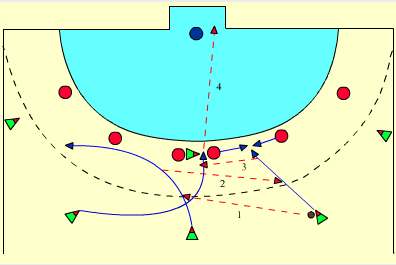
- RO plays pass to MO
- MO plays pass to LO, RO starts to put pressure between LH and UL and feints to centre, putting extra pressure initially between LH and UL and then between MA-l and UL
- LO puts pressure between MA-r and MA-l, CS comes from the circle towards LO, LO plays a pass to CS
- CS plays pass immediately back to LO
- LO makes use of the space created and completes the pass.
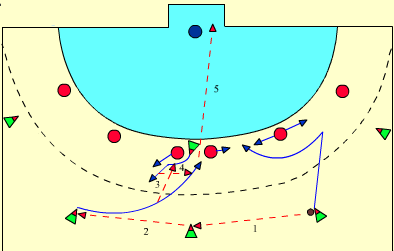
- The pass can be played to an in starting CS, MO, RO or RH. The ball is now played into the space where no player is present yet.
- The starting player must catch the ball in the run.
- Therefore, the pass should not be too hard and can best be played with a bounce (bottom pass).
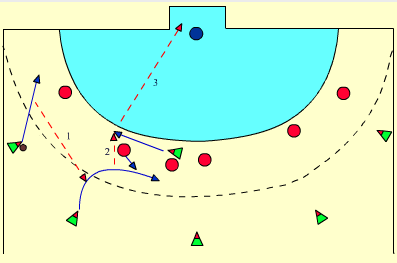
- RH puts pressure between MA-l and HL, MO puts pressure between MA-l and HL, RO starts in behind MO. This will cause MA-l and HL to go in, allowing a pass from RH to RO.
- CS puts pressure on MA-r, RO finishes off

- LO puts pressure to the middle, so UR joins, LH goes around HR to the circle
- LO plays pass to incoming LH
- LH rounds from circle, LH retrieves ball and joins LO row, LO joins LH row
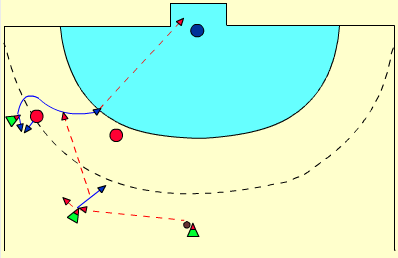
- This can be used against an opponent, who has focused all attention on the attackers and the ball.
- The team attacks and the coach calls a player to the transition area for "extra instructions". After a while, the attacking players shift the pressure to the other side of the field in order to get the defenders on that side.
- MO also moves to that side.
- RH must be free to play all the time, but must not be played.
- When the defense is in the desired position, the ball is passed to RH.
- RH now plays a pass to the closest builders.
- This is the signal for the coach to send the player into the field.
- MO runs to the defence and puts a barrage on the outside of the defence.
- The set-up player now plays a long pass to the player coming back from the change-over zone, who now has enough space to finish.
- This can also be used in the case of a temporary lock out
- If the team is in possession of the ball and the stoppage lasts about 10 seconds, pressure can be put on the defence in the same way and the excluded player can be sent back into the field, even with a few seconds delay.
